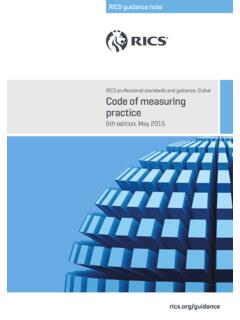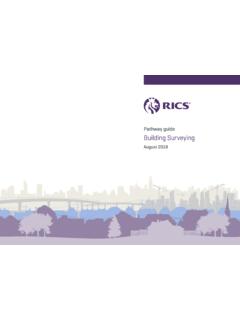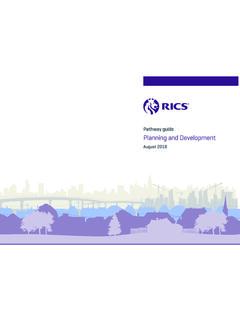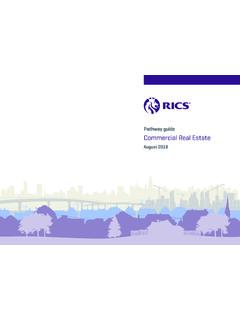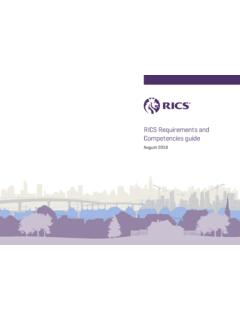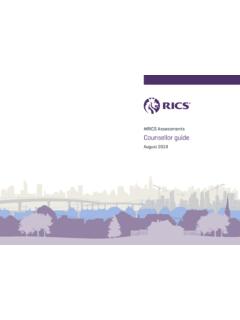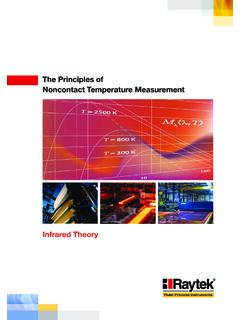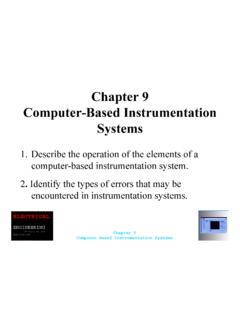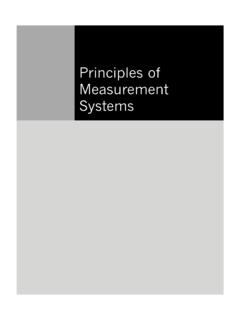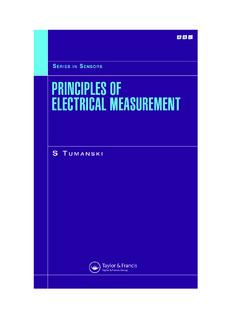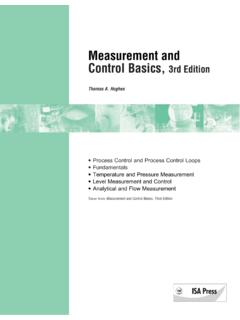Transcription of Principles of Measurement - rics.org
1 Principles ofMeasurement(International)For Works of ConstructionJUNE 1979 Published by RICS Business Services Limited,a wholly owned subsidiary ofThe Royal Institution of Chartered Surveyors,under the RICS Books imprint,Surveyor CourtWestwood Business ParkCoventry, CV4 8 JEUKNo responsibility for loss occasioned to any person acting or refraining from action as a result of any material included in this publication can be accepted by the authors, publisher or The Royal Institution of Chartered Surveyors. The views expressed and the conclusions drawn in this book are those of the 0 85406 108 8 First Edition 1979 Reprinted 1988, 1991, 1994, 2001, 2002 and 2004 RICS 1988. Copyright in all or part of this publication rests with the RICS, and save by prior consent of the RICS, no part or parts of this publication shall be reproduced in any form or by any means electronic, mechanical, photocopying, recording or otherwise, now known or to be by Q3 Print, LoughboroughForewordThe use of bills of quantities is a well-established means of enabling the financial control and management of buildingworks.
2 The key to the success of the use of bills of quantities is a clear understanding by all parties to the contract ofwhat is included, or excluded, in the Measurement . It is this that gives rise to the requirement for clearly definedstandard methods of these Principles of Measurement were first issued in 1979, many countries have developed their own moredetailed standard methods. A recent survey of its international membership carried out for the RICS ConstructionFaculty by the Building Cost Information Service (BCIS) identified that 14 of the 32 responding countries had theirown method of Measurement . However, the Principles of Measurement (International) (POMI) were still being used inabout half of the countries and are still widely used on international has been a trend in the UK and elsewhere to move away from Measurement -based procurement, passing theresponsibility for measuring the building work down the supply chain to the contractor or sub-contractor.
3 However,research commissioned by the Construction Faculty showed that where bills of quantities were not provided as part ofthe procurement process, 95% of contractors would undertake their own Measurement , with the majority of this carriedout in accordance with the current Standard Method of Measurement (SMM).There is no doubt that the proliferation of procurement practices will continue. However, in circumstances in whichthere is a degree of design certainty before the contractor is appointed, Measurement -based procurement will still beappropriate. Furthermore, where design decisions are being passed down the supply chain, Measurement should beundertaken at the level at which the design is carried out, in order to remove the need for is in the interests of the industry as a whole, including its clients, that Measurement is carried out consistently. Thereis therefore a continued need for standard methods of Measurement and, by implication, a continued need formeasurement Principles require a detailed specification and tender drawings to be provided.
4 RICS recognises thatcircumstances vary from country to country, and from contract to contract, and that the Principles therefore need to beflexible in order to accommodate variations in practice and comments on the Principles should be sent to the RICS Construction Faculty, at 12 Great George Street, ParliamentSquare, London, SW1P 3AD. The Principles are also available in French, German and is grateful to the original authors: Michael Rainbird, Alan Charter, James Diebel, Derek Lawrence and CashChairmanRICS Construction FacultyDecember 2003 ContentsSECTION GP - GENERAL Principles GP1 Principles of Measurement ..1GP2 Bills of quantities ..1GP3 Measurement ..1GP4 Items to be fully inclusiveGP5 Description of items ..1/2GP6 Work to be executed by a specialist nominated by the employer ..2GP7 Goods, materials or services to be provided by a merchant or tradesman nominated by the employer ..2GP8 Work to be executed by a government or public authority.
5 2GP9 Dayworks ..2/3 GPI0 Contingencies ..3 SECTION A - GENERAL REQUIREMENTSA1 Conditions of contract ..3A2 Specification ..3A3 Restrictions ..3A4 Contractor's administrative arrangements ..3A5 Constructional plant .. 3A6 Employer's facilities ..3A7 Contractor's facilities ..4A8 Temporary works ..4A9 Sundry items ..4 SECTION B - SITE WORKB1 Site exploration generally ..4B2 Trial holes ..4B3 Boreholes (including pumping test wells) ..4B4 Site preparation ..5B5 Demolitions and alterations .. 5B6 Shoring .. 5B7 Underpinning .. 5B8 Earthworks generally .. 5B9 Excavation ..6B10 Dredging .. 6B11 Disposal ..6B12 Filling ..6B13 Piling generally .. 6B14 Driven piling ..6B15 Bored piling ..7B16 Sheet piling ..7B17 Performance designed piling ..7B18 Testing piling .. 7B19 Underground drainage ..7B20 Paving and surfacing ..7B21 Fencing .. 8B22 Landscaping .. 8B23 Railway work.
6 8B24 Tunnel excavation ..8B25 Tunnel linings .. 8B26 Tunnel support and stabilisation ..9 SECTION C - CONCRETE WORKC1 Generally ..9C2 Poured concrete ..9C3 Reinforcement ..9C4 Shuttering ..10C5 Precast concrete .. 10C6 Prestressed concrete .. 10C7 Sundries .. 10/11 SECTION D - MASONRYD1 Generally .. 11D2 Walls and piers ..11D3 Sills, etc ..1104 Reinforcement ..11D5 Sundries ..11SE:CTION E - METALWORKE 1 Generally ..11E2 Structural metalwork ..11/12E3 Non structural metalwork ..12 SECTION F - WOODWORKF1 Generally ..12F2 Structural timbers ..12F3 Boarding and flooring ..12F4 Grounds and battens ..12F5 Framework ..12F6 Finishings and fittings ..12/13F7 Composlte items ..13F8 Sundry items ..13F9 Metalwork ..13F10 Ironmongery ..13 SECTION G - THERMAL AND MOISTURE PROTECTIONG1 Generally .. 13G2 Coverings and linings .. 13G3 Damp-proof courses ..14G4 Insulation.
7 14 SECTION H - DOORS AND WINDOWSH1 Doors .. 14H2 Windows ..14H3 Screens .. 14H4 Ironmongery ..14H5 Glass ..14H6 Patent glazing ..14 SECTION J - FINISHESJ1 Generally .. 14J2 Backgrounds ..15J3 Finishings .. 15J4 Sundries ..15J5 Suspended ceilings .. 15J6 Decorations ..15J7 Signwriting .. 16 SECTION K - ACCESSORIESK1 Generally ..16K2 Partitions ..16 SECTION L - EQUIPMENTL1 Generally ..16 SECTION M - FURNISHINGSM1 Generally ..16M2 Curtain track ..16 SECTION N - SPECIAL CONSTRUCTIONN1 Generally .. 16N2 Enclosures .. 16N3 Installations ..17 SECTION P - CONVEYING SYSTEMSP1 Generally ..17P2 Sundries ..17P3 Work incidental to conveying systems ..17 SECTION Q - MECHANICAL ENGINEERING INSTALLATIONSQ1 Generally ..17Q2 Pipework and gutterwork ..17Q3 Ductwork .. 18Q4 Equipment ..18Q5 Automatic controls .. 18Q6 Connections to supply mains .. 18Q7 Insulation, including linings and protective coverings.
8 18Q8 Sundries ..18Q9 Work incidental to mechanical engineering installations ..18 SECTION R - ELECTRICAL ENGINEERING INSTALLATIONSR1 Generally .. 19R2 Main circuits .. 19R3 Sub-main circuits .. 19R4 Final sub-circuits and auxiliary installations ..19R5 Accessories ..19R6 Control gear ..19R7 Equipment .. 19R8 Connections to supply mains ..20R9 Sundries ..20R10 Work incidental to electrical engineering installations ..20 APPENDIXA mendments to Principles of Measurement ..21 SECTION GP - GENERAL PRINCIPLESGP1 Principles of These Principles of Measurement provide a uniform basis for measuring bills of quantities for works ofconstruction. More detailed information than is required by this document may Measurement be given todefine the precise nature of work or the circumstances under which it is to be carried Amendments to these Principles of Measurement for use in a particular locality or adopted for work notenvisaged by this document shall be stated; an appendix is provided for such amendments to be These Principles of Measurement may be applied equally to the Measurement of proposed works and ofcompleted Bills of The objects of bills of quantities are: 1.
9 To assist in the accurate preparation of tenders, by providing for Measurement of quantities on a uniformbasis2. To provide a basis for the financial control of a project, in accordance with the conditions of Bills of quantities shall describe and represent the works to be carried out; work which cannot be measuredaccurately shall be described as approximate or given in bills of approximate Conditions of contract, drawings and specifications shall be provided with the bills of The section headings and classifications do not impose restrictions upon the format and presentation of billsof Work shall be measured net as fixed in position and each Measurement shall be taken to the nearest 10millimetres; this principle shall not apply to dimensions stated in Unless otherwise stated, no deduction shall be made from items required to be measured by area for voids ofless than Minimum deductions of voids shall refer only to voids within the edges of measured areas.
10 Voids which are atthe edges of measured areas shall always be deducted, irrespective of These Principles of Measurement may be used with other units of Measurement but the particular amendmentsshall be Notwithstanding these Principles of Measurement , a separate minor building or structure may be Items to be fully Unless otherwise stated, all items shall be fully inclusive of all that is necessary to fulfill the Items to be fullyliabilities and obligations arising out of the contract and shall include: 1. Labour and all associated costs2. Materials, goods and all associated costs3. Provision of plant4. Temporary works5. Establishment charges, overheads and Description of Items which are required to be enumerated. or for which an item is required, shall be fully Items which are to be measured by length or depth shall state the cross-sectional size and shape, girth orranges of girths or such other information as may be appropriate; for items of pipework it shall be statedwhether the diameter is internal or Items which are to be measured bv area shall state the thickness or such other information as may Items which are to be measured by weight shall state the material thickness and unit weight if appropriate (forexample, ductwork).
